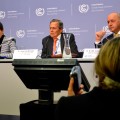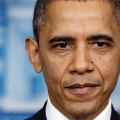Last week saw Christiana Figueres, the head of the United Nations Framework Convention on Climate Change (UNFCCC), in Australia to promote the importance of international climate policy this year across multiple sectors. In keeping with her busy schedule she spoke at events hosted by non-governmental organisations, business groups, universities and state governments.
2015 is a big year for the UNFCCC, with countries due to finalise a new international agreement on climate change action in Paris later this year. The last time countries tried to reach a new climate agreement of comparable significance was in 2009 in Copenhagen. The aftermath of Copenhagen is well known, with these talks being widely criticised as countries failed to produce a new legally binding instrument to address climate change.
Figueres has struck an optimistic tone at many of her appearances this year, with Australia being only one of many countries that she has visited in addition to the Philippines and France. Part of her role includes encouraging countries to build positive diplomatic momentum in the lead up to Paris.
In her speech at the Australian National University, Figueres outlined reasons why Paris is likely to be more successful than Copenhagen:
- The context of the agreement has changed
One of the promising trends Figueres touched on was the decoupling of growth in gross domestic product (GDP) and growth in greenhouse gas emissions. Statistics are showing that in the past five years the Organisation for Economic Co-operation and Development (OECD) countries have achieved an average of seven per cent growth at the same time as a four per cent reduction in greenhouse gas emissions. In 2014, China’s GDP increased by seven per cent and emissions decreased by one per cent. Most importantly Figueres highlighted that: “2014 was the first year that global growth increased while emissions stayed flat.”
Decoupling growth from emissions is crucial to show how countries can progress economically whilst also acting on climate change. This is especially important for developing countries and emerging economies, which are generally not the main contributors to climate change and should not be economically disadvantaged by playing their part to reduce greenhouse gas emissions.
- Renewable energy has increased in efficiency and decreased in cost
Another positive trend outlined by Figueres is that in many countries renewable energy is now cost competitive with fossil fuels in terms of generation, storage and job creation. Innovation in this sector has also taken off including Tesla’s recent release of the ‘power wall’, a revolutionary new household energy storage system. Last year alone, $270 billion was invested in renewable energy world wide, which was the greatest dollar amount invested into any form of energy in 2014.
This significant increase in the efficiency and affordability of renewables means that countries will find it easier to adopt these technologies. More directly, cheaper renewables will enable countries to set more ambitious emissions reduction targets.
- The shift in demand for coal
Figueres’ optimism ahead of Paris is also closely tied to decline globally in the demand for coal. OECD countries are also flattening out their demands: the United States energy policy is becoming increasingly self-sufficient, moving away from coal imports and towards renewables. These shifts are important as coal currently provides 40 per cent of the world’s energy needs and its demand is expected to reach nine billion tonnes per year by 2019. Shifting this demand for coal downwards is a positive step towards reducing dependence on coal.
Previously, a significant portion of the demand for coal was coming from emerging economies, however the tide is turning there as well. As Figueres pointed out, some developing countries are now looking towards clean development pathways in conjunction with adaptation measures to reduce their vulnerability to climate change.
- Policy mechanisms are now in place
Since Copenhagen, many countries have passed national legislation to reduce emissions through a range of different mechanisms: Figueres’ final source of optimism. According to the World Bank, in 2014 approximately 40 national and 20 sub-national jurisdictions were putting a price on carbon which accounted for about 12 per cent of annual global emissions. Figueres pointed out that countries are implementing these measures “independently of the convention [UNFCCC]” and that many are “realising it’s in their national interest to make [emissions reduction] investments and protect their national infrastructure”. These trends demonstrate to the international community that there are implementable solutions to reduce greenhouse gas emissions.
Despite the optimistic context that Figueres spoke of, she also identified several major challenges faced on the road to Paris.
- Ensuring countries fairly participate in a new climate agreement
One of the key challenges Figueres identified is ensuring countries contribute their fair share under the new agreement. Under the Kyoto Protocol countries’ responsibilities were differentiated depending on whether they were classed as ‘developing’ or ‘developed’. As many countries have experienced rapid development, the main emitters have now changed with the rise of emerging economies like China and India. Developing countries now have mitigation responsibilities as well as the need to adapt to the effects of climate change they are already experiencing.
- Barriers in achieving the 2°C goal
Figueres is a realist, reminding her Canberra audience that: the Paris agreement should not be the only vehicle to achieving the emissions reductions necessary to keep warming at the internationally agreed 2°C limit. Given the critical urgency for action on climate change, this may be a hard idea for many to accept. This means that sub-national actors and citizens will continue to have a critical role to play in adding to the efforts that governments undertake to reduce emissions.
- Ensuring the legal basis for an agreement
One of the challenges that Figueres identified was how to ensure that the new agreement has a legal basis.
One of the lessons learnt from implementing the Kyoto Protocol was the importance of legal ratification, and this is a challenge that Figueres faces in working towards a legally binding treaty to prevent similar issues as to when America was previously unable to ratify Kyoto domestically through their congress.
Paris presents a number of opportunities but also a number of challenges that will shape the new agreement. The key question on everyone’s mind is: how?
Countries have already agreed on a 47-page document that details all options that can be considered at Paris, and in the lead up to through the intercessional process. Even though there are many issues to be negotiated, all possible outcomes must come from that document. The solutions have been identified—countries just need to agree on them.
Figueres described the new agreement as a “highway” where countries can choose what lane to travel in but, at the end of the day, they’re all headed towards the same destination: one where a global rise in temperature does not exceed 2°C. The agreement will need to be flexible to ensure that country’s opt-in and comply, whilst still clearly aiming to achieve this goal.
It bodes well that Figueres is so optimistic. As the chief UN diplomat with responsibility for overseeing a successful negotiations process, she has to be. Despite the major challenges she is working on resolving, it is important for her to appear positive to build trust in the process. No doubt, for the rest of 2015 she will be continuing this optimistic approach whilst helping countries to resolve the issues that may hinder an agreement in Paris.
It is clear there has been significant progress in multilateral politics, policy implementation and technology development since the Copenhagen talks. There are still enormous challenges, but Paris can and must succeed.













comment